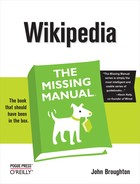Once you’ve added a bunch of good stuff—content and sources—then you’re in a much better position to remove content that doesn’t add materially to the article. Some editors call such useless information cruft, and most readers hate it. Furthermore, per WP:NPOV, giving undue space to any particular aspect of a topic is a violation of the neutral point of view. It may be worth mentioning that someone has eight honorary degrees, but a list of them all is pure cruft.
Remove trivia. Trivia, by definition, is not encyclopedic. Editors frequently remove trivia sections, sometimes pasting the content to the article talk page, and you should do the same. If a trivia sections happens to contain any important facts, you can work them into the rest of the article. Sometimes trivia sections masquerade under the names “Other facts”, “Miscellaneous”, and “In popular culture.” For details, see the guideline Wikipedia:Trivia sections (shortcut WP:TRIVIA).
Remove unnecessary links in the “See also” section. As mentioned on ???, this section should “ideally not repeat links already present in the article”. At minimum, you should make sure it has no links to articles that are only vaguely related to the topic, or articles that don’t exist yet.
Remove unnecessary duplication among sections that list sources. A “Further reading” section, if there is one, shouldn’t contain any sources used as citations—those are already in the “References” section. Nor should it include anything also in the “External links” section, or the body of the article (for example, books written by the article’s subject).
There should be minimal duplication between the “External links” section and the “References” section. In general, if something is cited as a source, it shouldn’t also be listed in “External links”. (The reader can figure out, if there’s a blue link in a footnote with an icon indicating it’s not a wikilink, that it’s an external link.) The exception to the “no duplication” rule is Web sites identified with the subject of the article—an organization’s Web site, a politician’s campaign Web site, a celebrity’s official publicity page, and so on. Readers expect to find these things at the top of the “External links” section, so they don’t have to search through footnotes for them. Other than that, however, duplication is not only pointless, but gives undue weight to links listed twice over those only listed once.
Remove linkspam, if you’ve not already done so. The “External links” section should be limited to official Web sites and similar closely related links, along with links to sources that could have been used for footnotes but weren’t (due to lack of time, for example). For details, see ??? and the guideline Wikipedia:Spam (shortcut: WP:SPAM), and the guideline Wikipedia:External links (WP:EL).
